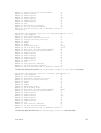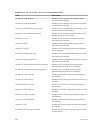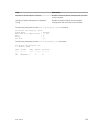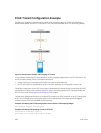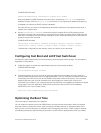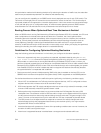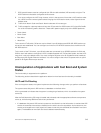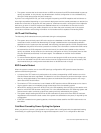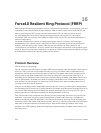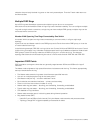7. BGP graceful restart must be configured with GR time left to default (120 seconds) or higher. The
BGP hold timer should be configured as 10 seconds.
8. You must configure the LACP long timeout, which is the amount of time that a LAG interface waits
for a PDU from the remote system before bringing the LACP session down, to be higher than the
default value.
9. Traffic from North-South and South-North nodes are of line rate type.
10. Traffic outage for a planned reboot is less than 30 seconds for 4000 routes of IPv4 and IPv6 traffic
for all of the following traffic directions. These traffic patterns apply only to the S6000 platforms.
• South-North
• North-South
• East-West
• West-East
To the south of ToR switch, 96 servers can be linked. Up to 8 Multiprocotol BGP (MP-BGP) sessions to
the servers are established. You can configure a minimum of 2 MP-BGP sessions and a maximum of 8
MP-BGP sessions.
To the north of the ToR switch, up to 8 leaf nodes are connected. Up to 8 EBGP sessions for IPv4 and
IPv6 for each leaf node are configured. LACP is enabled between the ToR and leaf nodes, and the LACP
long timer is set to the default value. You must configure 96 ports to be 10-Gigabit Ethernet interfaces
and 8 ports as 40-Gigabit Ethernet interfaces. You must configure the switch to operate with an uplink
speed of 40 Gigabit Ethernet per second.
Interoperation of Applications with Fast Boot and System
States
This functionality is supported on the platform.
The following sections describe the application behavior when fast boot functionality is enabled:
LACP and IPv4 Routing
Prior to the system restart, the system implements the following changes when you perform a fast boot:
The system saves all dynamic ARP entries to a database on the flash drive.
A file is generated to indicate that the system is undergoing a fast boot, which is used after the system
comes up.
After the Dell Networking OS image is loaded and activated, and the appropriate software components
come up, the following additional actions are performed:
• If a database of dynamic ARP entries is present on the flash drive, that information is read and the ARP
entries are restored; the entries are installed on the switch as soon as possible. At the same time, the
entries are changed to an initial (“aged out”) state so that they are refreshed (and flushed if not learnt
again). The database on the flash card is also deleted instantaneously.
Flex Hash and Optimized Boot-Up
345



